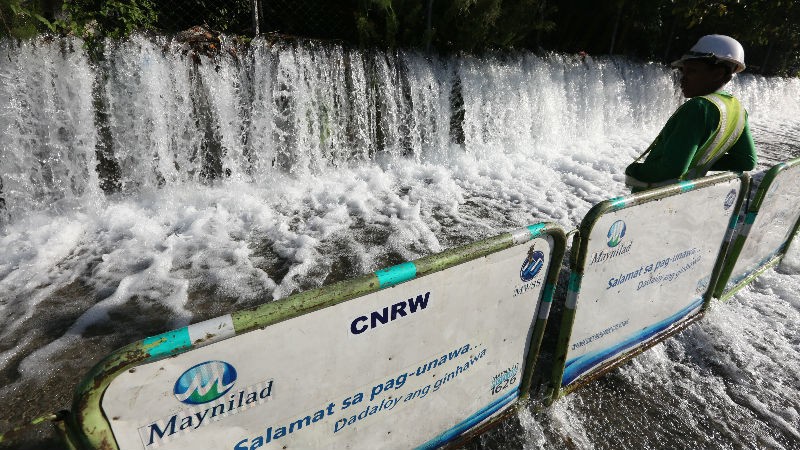
Maynilad water pipes broke along Ramon Magsaysay Boulevard in Sta. Mesa, Manila, February 11, 2016, causing floods in the low-lying areas. NIÑO JESUS ORBETA/ PHILIPPINE DAILY INQUIRER
The water pipe that gave way to inundate parts of Manila last week added insult to the injurious irony: the precious resource gushing violently onto the street and literally going down the drain, while in Mindanao wide swaths of land lie shriveled in the drought, crops gone to nothing, farmers and their families on the edge of famine.
The outrage lasted all of 10 hours. Per the account of Maynilad Water Service Inc., a faulty 1,050-mm pipe located on Ramon Magsaysay Boulevard in Manga, Sta. Mesa, suffered a busted valve, and a geyser of water shot out shortly before midnight Wednesday. Maintenance workers were repairing a main pipeline on the street when the temporary valve broke, producing a flash flood that drew frolicking children as well as their elders toting water pails and other containers and intending to take full advantage of the mishap.
Of course, the so-called “Sta. Mesa Falls” was hardly fun for motorists during the Thursday morning rush hour. The traffic buildup was tremendous. It got worse: All that “free” water resulted in an interrupted supply to some 200,000 Maynilad customers in the cities of Manila, Las Piñas, Muntinlupa, Parañaque, and Pasay as well as parts of Cavite. A team managed to stop the water surge by Thursday noon. In reports, Maynilad officials would not give the exact amount of water lost, only saying that it was “minimal and not even 0.1 percent of the water supplied in our concession area in a day.”
Cold comfort. In Mindanao, farmers cry vainly for water to irrigate their fields. El Niño is a ruthless enemy.
And this year’s El Niño is predicted to be the most intense in the last 50 years. The weather bureau Pagasa has identified nine provinces in Mindanao most likely to be afflicted: Zamboanga del Norte, Zamboanga del Sur, Zamboanga Sibugay, South Cotabato, Sarangani, Sultan Kudarat, Basilan, Maguindanao and Sulu. In January, the Maguindanao provincial board declared a state of calamity, with El Niño damaging as much as P150 million worth of local agriculture, and 10,000 farmers losing their shirts in the process. A 37-year-old farmer’s suicide is being blamed on depression brought about by the dry spell that destroyed his crops in the town of South Upi. Zamboanga City itself is in a state of calamity. Water is now being rationed there, and Archbishop Romulo de la Cruz has called on the people to pray for rain.
Things are bound to get even worse: Pagasa has predicted a hotter-than-usual dry season, with Mindanao possibly experiencing temperatures as high as 39 degrees, and the extreme weather possibly lasting until May.
All these in a country marked by both extreme wealth and extremely limited resources. Running water is actually a luxury in many rural areas: Men, women and children have to walk long distances to get their scant supply and lug it back. City folk, pampered and blasé, should be aware of and count their blessings.
The sight of the accidental waterfall on a Metro Manila street should be sufficiently horrific. Think of how old and overworked the water system is. Per reports, in 2015 Maynilad had to repair more than 18,000 pipe leaks throughout its coverage area. A leisurely drive through the metropolis would reveal busted pipes, often left unattended for weeks, even months.
El Niño has led visiting American water conservationist Thomas Pape to recommend various water-saving tips (actually a no-brainer): lessening the use of the toilet flush, washing dishes using a basin, reducing laundry loads by wearing clothes twice, and taking shorter showers, among others. “There could be months and months of 60 percent less rainfall in your country. This could be a calamity for the Philippines,” Pape said.
Time again to raise the call for water conservation and hope it would not fall on indifferent ears given that El Niño is not showing signs of abating and the dry season will soon be upon us. The sight of shrieking children cavorting in the “Sta. Mesa Falls” might seem amusing to some, but the unforgiving drought should remind everyone that not for nothing are future wars predicted to be fought over water.

